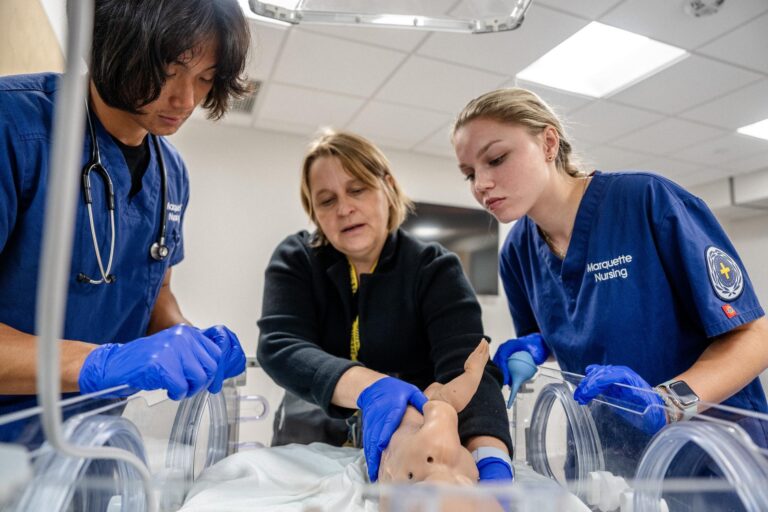Dr. Theresa Bullis was usually on the hospital floor an hour before her students arrived when she taught clinical rotations, just as the sun poked over the horizon. She’d run through a standard list of questions with the charge nurse from the night shift: How many patients? Any who are particularly good for students to see today? What do I need to tell the students when they get here?
“A lot of nurses on the floor in our partner hospitals enjoy working with our students and kind of take them under their wing,” says Bullis, who now coordinates other clinical instructors. “They’ll pull them into rooms and try to teach them something new.”
Teachers like Bullis are vital for facilitating those relationships while overseeing student learning at clinical sites. Dozens of clinical faculty members help students translate the nursing principles they learn in the classroom to actual patient care, both in clinical settings and simulations. Most clinical instructors are currently practicing in hospitals.
“Our role as clinical instructors is to have the expertise to guide someone through how to take care of other people.”
Dr. Theresa Bullis, Clinical Instructor
Bullis used to oversee a small group of sophomores in a long-term care facility, which is the first pre-licensure clinical rotation. As students conducted head-to-toe assessments, took blood pressure readings and practiced other basic nursing skills, Bullis was a constant presence, guiding the students as they learned how to be a nurse. She brings her experience teaching and supporting patients from community clinics to the classroom.
“Our role as clinical instructors is to have the expertise to guide someone through how to take care of other people. I did a lot of that with the patients directly before becoming a professor,” Bullis says.
The faculty who work in the simulation lab play just as big a role in students’ development. That’s what Clinical Instructor Dr. Amanda Potter does — she first gained simulation expertise in her clinical role and now uses that knowledge to develop students’ clinical judgment in the Ascension Center for Clinical Simulation and Learning.
“We use simulations so that students understand the clinical reasoning behind their actions; so many learners come to us knowing roughly what they’re supposed to do, but not knowing why,” Potter says. “Debriefing with a trained clinical instructor allows students to figure out the logic behind proper nursing care and that’s super important.”
It’s all part of developing students’ critical thinking, one of the five qualities of a Marquette Nurse. Each Bachelor of Science in Nursing student completes hundreds of clinical hours between six rotations on top of the hours they spend in the simulation lab. That time is spent honing decision-making and clinical judgement: the kind students will have to use every day in practice.
It is the role of clinical faculty to keep students on track in that learning process. Overseeing a group of six to eight students each, clinical faculty serve as references for students who have questions and as sounding boards for any ideas or concerns students might have. Just as students are practicing their judgment, professors are too. They decide when to step in and help a future nurse with a particular problem and when to step back, allowing them to figure it out on their own.
“Students in these settings are functioning right on the edge of their expertise,” Potter says. “They may not have all the knowledge or skills they need when they first come in, but they’re there to learn and practice. My job is to make simulation a safe place to do that, just like it’s other faculty members’ job to do the same in the hospital.”
“Clinical rotations can be a scary experience for students at first. You cannot always predict how your day will go,” Clinical Instructor Jenni Strait adds. “Students know we’re not going to let them make a big mistake, but they also want an instructor who doesn’t give them the answer all the time.”
Seeing students grow over the course of a semester is one of the most satisfying parts of any clinical faculty member’s job. It’s what first attracted Bullis to the role years ago and why she still finds it one of the most fulfilling things she’s done in her nursing career.
“From the first day of students’ clinical to the last day, they make huge strides toward becoming ready to safely see patients on their own. Seeing the ‘a-ha!’ moments hooked me from the start,” Bullis says.



